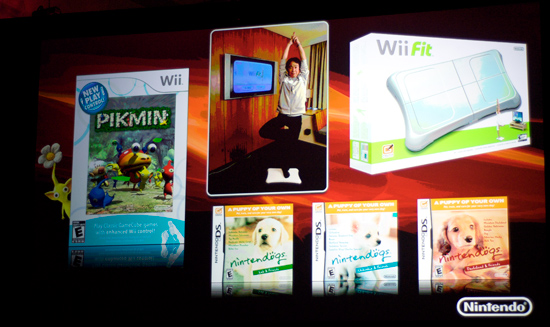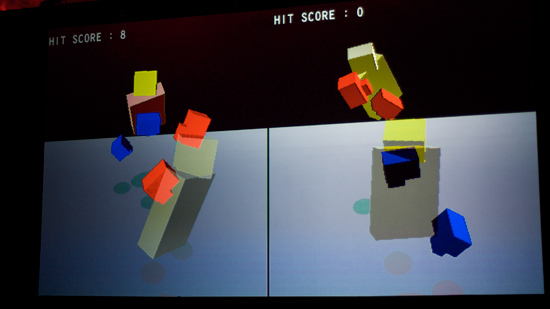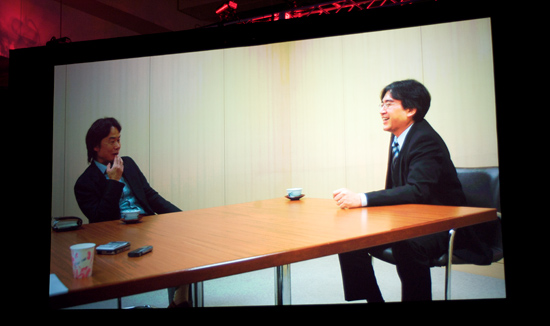Nintendo's Development Secrets, Cloud Gaming & new Killer NIC - GDC '09
by Anand Lal Shimpi & Derek Wilson on March 26, 2009 12:00 AM EST- Posted in
- Trade Shows
Miyamoto’s World
Miyamoto draws his inspiration from observation. He looks at other humans and watches how they interact, what they enjoy doing, etc... When he sees an activity that people enjoy he focuses on why they find that activity so entertaining. He thinks about things that most people just glaze over; most people know when they’re having fun, they don’t focus so much on why they’re having fun. He analyses himself and others in order to discover new ways to develop games that capture the fun people already know how to have. Miyamoto draws his inspiration from the life around him; he doesn’t sit down to make a game, he looks at what he and others enjoy in life and uses that to spark the innovation.
Iwata gave two examples; the first was when Miyamoto got a new garden, Pikmin shortly followed. And when Miyamoto got a new dog? Nintendogs came about.

With the idea in mind, Miyamoto uses basic personal communication to start talking about it. He grabs a very small team and doesn’t do anything formal, they just talk. Miyamoto is all about personal communication, and that’s what happens here.
The next stage is to take this small team and begin prototyping the game. There’s no need for polish here, or anything other than the core concept of the game. As an example, this was the original prototype of Wii Boxing:

It’s not particularly attractive. There are no impressive shaders being used here. Miyamoto simply wants to test the basic mechanics of the game to see if it’ll be fun. The prototype stage is only concerned with the simple idea itself; don't worry about extraneous details - just core gameplay.
These small prototyping teams are sometimes only one developer large. There are often multiple projects in the prototype stage at the same time. This prototype stage can sometimes last as long as two years; not every concept ever makes it out of this stage, but Miyamoto never throws away the work that’s been done. While a prototype game or feature may not be used for the current project, it may come in handy somewhere down the line. Iwata said that he often times saw prototypes show up in games further down the line in ways you’d never expect.
It’s impossible to know what will be fun without trying it first. Miyamoto employs extensive use of trial and error in his prototyping stages, but that’s the beauty of not building fancy prototypes. If the concept doesn’t work, there’s not much extraneous work lost - it was simply a learning experience.

Miyamoto (left) and Iwata (right)
When a prototype succeeds, then and only then can the game get to a planning stage. This is where the documents come out and we start seeing some structure. With the core gameplay already defined, the next stage is mass production where the actual game is put together. The approach is very front loaded; if the core gameplay is done properly thanks to a well executed prototyping phase, building the rest of the game can go smoothly and according to schedule.
While the mass production stage is usually predictable, sometimes it does yield surprises. One of Miyamoto’s traits is that he never gets angry with his team when things don’t go according to plan. Mistakes are made and instead of a yell-fest, Miyamoto will even go as far as to personally help get things back on track. Iwata talked about it like someone turning a table upside down; Miyamoto helps pick up the pieces and put it back in order, rather than complain about the mess that was just made.

Because of Miyamoto’s aggressive focus on the prototyping stage, a game never needs to be restarted from scratch once it’s at the mass production phase. The prototype stage produced a well defined core concept. Sometimes ideas need to be dropped from the title because they don’t work out, but as I mentioned before, Miyamoto saves the ideas and can reuse them in later completely unrelated projects.
Iwata spoke of the “Death Spiral” in game development. Game developers face financial pressure to get games out on time; the developers rely on game sales to fund both current and future projects, so without that revenue stream there’s no hope for game development to continue. The financial pressure leads to less time to work on and perfect a game, which then leads to poor quality and poor sales. The spiral continues downwards until the developer can no longer remain competitive in the industry.
Iwata himself saw this death spiral first hand, as his previous job as a developer left him with 2 days to ship a title that needed months worth of work. Iwata sacrificed the quality due to sales pressure and eventually had to help restructure his company (HAL Laboratory) for bankruptcy. A much younger Iwata blamed finances alone for his employer’s failure as a game developer, but today Iwata believes that it has just as much to do with talent and approach to game development. His change in perspective is thanks to one man in particular: Shigeru Miyamoto.
According to Iwata, it’s Miyamoto’s methodical yet youthful approach to game development that gives him, and thus Nintendo, the edge. Iwata’s goal was to share one of Nintendo’s secrets success with the game developers in the audience. I just liked knowing how someone as significant as Miyamoto goes about his job.










38 Comments
View All Comments
arturnowp - Friday, March 27, 2009 - link
Resolution is not that big problem. Imagine 720p with 16x AA. There is resolution bound caused by netword bandwidth not because of data center perfomance.MrSAballmer - Thursday, March 26, 2009 - link
Interesting stuff here, especially the fishnet-girls!http://fakesteveballmer.blogspot.com">http://fakesteveballmer.blogspot.com
spuddyt - Thursday, March 26, 2009 - link
I mean, a fat red plumber jumping on mushrooms....drwheel - Thursday, March 26, 2009 - link
That's how the article reads anyway.It amazes me that bigfoot networks is still in business. Another killer nic product that delivers marginal improvements that are rivalled by a $25 intel card:
http://forum.ncix.com/forums/topic.php?id=1304406">http://forum.ncix.com/forums/topic.php?id=1304406
And a streaming video game system! Awesome. Seeing as how gamers like myself already complain about latency on lcd monitors that claim to have single-digit ms response times (not always true), or who can easily notice a different between at 20ms versus a 100ms ping time to a game server, I'm sure throwing another 80ms of lag in there because your game is being pre-rendered elsewhere won't hurt either! Haha.
What a joke. Is this the best stuff there is to report about at GDC?
SSDMaster - Thursday, March 26, 2009 - link
They've really done something unique with onLive though... you gotta hand it to them.They've created a new type of lag.
Before you just had to wait till the server showed you where your enemies were, but NOW you get to wait to see your character turn every time you hit the control stick...
GENIUS!
drwheel - Thursday, March 26, 2009 - link
And let's not forget the other issues with this platform aside from latency. This company better have a ginormous data center with tons of mid to high-end systems, each one with a dedicated gfx card for each player, and gobs and gobs of bandwidth on a very reliable backbone. We're talking about AIG bailout money here.This entire venture just sounds like something that will never get off the ground. And even if it does, there is a list of logistical issues that will cause it to fail. Sorry, but this sounds like the next "Sega Channel" or better yet... Phantom game console.
Good idea, but there is no way it will ever work. Atleast, not until this country's network infrastructure is improved to a point where coast-to-coast latency is in the single-digit millisecond range, and everyone has atleast 10Mbps bandwidth in their home (read: not for at least another 10 years).
bespoke - Thursday, March 26, 2009 - link
"And let's not forget the other issues with this platform aside from latency. This company better have a ginormous data center with tons of mid to high-end systems, each one with a dedicated gfx card for each player, and gobs and gobs of bandwidth on a very reliable backbone. We're talking about AIG bailout money here."Right - this is the point I don't understand. We've got to be talking about quite huge hardware investment per user to run these things. Maybe $500 of hardware per user? Are these guys really going to spend that much money up front? Are they going to be able to recoop that money? Will they upgrade hardware every 6-12 months to stay up with games?
baba264 - Thursday, March 26, 2009 - link
I believe I may be able to offer some insight on this question. In my opinion you forget three major facts.The first one is that the game resolution offered are calibrated for the tv. Either standard 800x600 tv, or 1024*720 HD tv, but either way, compared to the kind of resolution we're talking about in a high end gaming rigg, this is very low.
The second fact is that they're probably not going to be running their games on indivdual pc, but rather on a cluster of workstations with high end graphic cards and maybe dedicated hardware for physics rendering. Considering the resolutions involved, one may be able to run quite a few instances of a game on a single machine.
The third is that, given the resolutions offered and the latency issues, this seems to me like a product aimed much more at the console crowd and maybe the notebook crowd than at the pc gaming one.
To sum it up there must be some large input of money to start up the thing, but if it's well designed, one may be able to add to load capacity without changing the architecture, just by plugging in new machines. So the initial investment is just a few machines and all the design and software to run the thing. Furthermore, one does get some economy through scaling so the number are not as bad as they seem. And since it's aimed mostly at the console crowd, that's more used to latency, the add up might not be an issue in most games.
So all in all, seen as something to replace your console (and not your pc) or to get into gaming if you don't have any hardware yet, this seems like a fairly good idea to me. However, I am concerned, as others have expressed before me, with the impact this traffic will have on Internet as a whole if this service becomes popular.
araczynski - Thursday, March 26, 2009 - link
i'm really hoping onlive gets traction, it would catch the industry off guard at the least, but i'd think for the most part the developers would love it.great way to fight piracy and gamestop, not to mention opening up a whole new potential userbase for developers to sell to, i.e. those that don't want to waste time/money on buying/building crazy gaming rigs.
the 720p limitation at the moment does worry me a bit, but then again that's probably not that big of an issue when the device is hooked up to say a laptop screen, as opposed to a tv/monitor.
in any case, broadband speeds are only increasing, even in the backwater US, so full 1080p shouldn't be all that far off.
The0ne - Thursday, March 26, 2009 - link
Speed increase with download/upload caps. Yea, good combo alright.